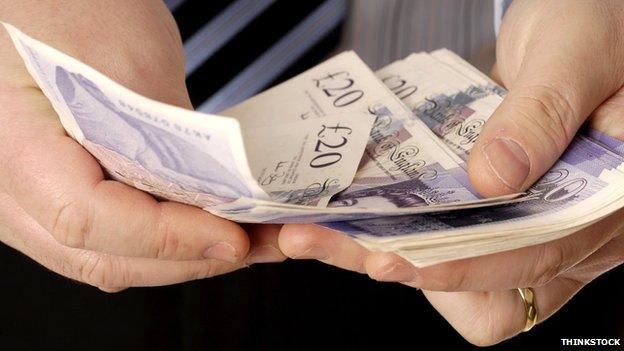A £6bn Budget windfall
- Published
- comments

Wednesday's Budget will show that by the end of the next Parliament, public spending cuts are expected to be £3bn or £4bn less than was forecast in December and the annual surplus could be around £2bn bigger.
Or to put it another way, the fall in inflation expectations generates an annual windfall for the Treasury of around £6bn.
Of this £3bn or £4bn will automatically feed through to more money being available for public services and a couple of billion will come off annual borrowing (or more accurately, by the end of the Parliament that couple of billion pounds will augment a projected surplus of £23bn).
The reason for this is that falling inflation reduces annual up-rating of welfare payments, and also reduces the interest payments the Treasury is forecast to pay on a national debt that is set to rise to £1.6 trillion next year.
As I understand it, the reduction in the squeeze to be imposed on public services is more or less automatic, rather than being a political decision by the Chancellor, George Osborne.
That is because the Treasury has given the Office of Budget Responsibility - the official forecaster of the deficit - figures for what will happen to total public expenditure for the whole of the next parliament.
And when inflation reduces outlays on welfare, that automatically implies there will be more cash available for expenditure on schools, hospitals, the police and so on.
Or to put it another way, the budget will show that there will be around £4bn a year less austerity than looked to be the case in the Autumn Statement just over three months ago.
So would this fundamentally change both the magnitude of spending cuts likely to be imposed by a Tory government on core public services, and the nature of the big argument between the Conservatives and Labour?
Not on its own.
Even if there is £4bn odd more to spend, departments that aren't shielded from cuts - that is all apart from health, education and overseas development - would still face a squeeze in their budgets of around a quarter.
And public spending as a share of GDP, or national income, would still fall to around 36% - or a proportion that hasn't been seen since the late 1930s.
What's more, the gap between what a Labour government and Tory government would cut would remain at around £50bn a year (equivalent to roughly half the annual budget of NHS England).
Which implies that a big political judgement still has to be made by George Osborne: whether to commit a Tory government to hit those OBR forecasts, or whether to say (either tomorrow or some time before the election) that the Tories are only hell-bent on generating an overall surplus of any magnitude, rather than the £23bn or £25bn the OBR will forecast tomorrow.
Because if that £23bn odd is no longer the test of his fiscal rectitude, he would have £23bn available for tax cuts or a lesser squeeze on public services.